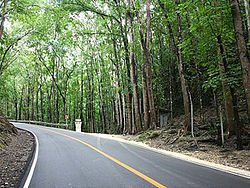Changa Manga
The Changa Manga (Urdu: چھانگا مانگا) is a planted forest which includes a wildlife preserve, in the Kasur and Lahore districts of Punjab, Pakistan. It is located approximately 80 kilometers south-west of Lahore. It was once the largest man-made forest in the world but has undergone illegal deforestation at a massive scale in recent times.[1][2]
Changa Manga is known more widely as "one of the oldest hand-planted forests in the world",[3] and hosts a wide variety of flora and fauna. The forest is home to 14 species of mammals, 50 species of birds, six species of reptiles, two species of amphibians and 27 species of insects.[4] Thus, other than producing timber for the local industry, the forest also serves as an important wildlife reserve.
Named after two brother dacoits, the Changa Manga forest was originally planted in 1866 by British foresters. Its trees were harvested to gather fuel and resources for the engines employed in the North-Western railway networks.
Location:-
The Changa Manga forest can be entered from a road off the N-5 Highway near Bhai Pheru and Chunian. At present, the forest covers an area of 48.6 square kilometres (12,000 acres).[8] It was once the largest man-made forest in the world but massive deforestation has reduced it to less than half its original size.[1] It is also known as "one of the oldest hand-planted forests in the world".[3]
The forest plantation dates back to 1866 and was planned to fill the need for timber and fuel resources for the North-Western railway networks. The most common species of flora are Dalbergia sissoo (Sheesham) and Acacia nilotica (Kikar), both members of the Fabaceae and native to the Indian subcontinent. Morus alba (white mulberry) was also introduced to the plantation and became popular in cultivation throughout South Asia. The forest also has several species of Eucalyptus and Populus.[9]
Read more from: https://en.wikipedia.org/wiki/Changa_Manga

copy from : https://en.wikipedia.org/wiki/Changa_Manga
